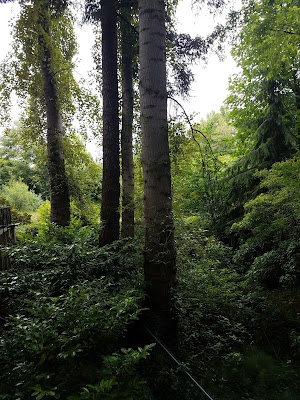I am sitting through another meeting where someone is saying that it is ok about the trees being cut down because there will be replacement trees planted. I sigh. I have come to learn that our public education system teaches people nothing about trees, and thus most people know nothing about them. Most of us cannot identify anything but the most basic trees a Maple, an oak or an "evergreen" (which is really many many trees which we are lumping into one category.) We view trees as pretty, and practical - meaning they are good for building stuff and making paper. But because they can "grow again" we think nothing of cutting them down.
Here is a list of some of the things I wish people understood about trees:
Trees Improve Air
Quality by removing pollutants
Lower Asthma
Rates
Studies show lower rates of Asthma in neighborhoods with
greater tree density. Low income
neighborhoods tend to have fewer trees making this an equity issue.
Prevent Heat
Islands
Cities can be 12F higher than other areas because of
density. Under climate change this can
be fatal.
Lower Heating
and Air Conditioning Bills
Trees provide cooling benefits in the summer and wind-chill
reduction in the winter resulting in energy savings in nearby buildings.
Olympias street trees in 2019 alone provided energy savings of 785,00 about
$330 per building.
Storm Water
Retention
Trees reduce and slow stormwater by intercepting rain in
their leave and branches. It is soaked
up by tree roots rather than runoff from streets and sidewalks. This can help prevent flooding, stream bank
erosion, habitat destruction, sewer system overflows and contaminated water
bodies. The technological ways of
managing storm water are expensive!
Drought
Prevention
By roots drawing water into the ground they help lessen the
impacts of drought. This will increasingly matter with climate change.
Wildlife and
Insect Habitat
Trees provide critical habitat for birds, mammals and
insects. Part of the loss of bird
diversity is attributed to loss of habitat.
Mental
Health benefits from proximity to trees
Studies show lower levels of depression if people can even
see a tree out their window.
Aesthetics/
increase property values
We of course find trees beautiful but that beauty also
translates into higher property values.
Trees absorb carbon dioxide from the atmosphere. The carbon is stored in its roots and in the
soil, thus reducing carbon emissions in the air (carbon sequestration.) Carbon
sequestered in this way helps to maintain and regenerate the surrounding
community of trees and other plants. As long as the tree is allowed to live, it
continues to store carbon and keep it out of the atmosphere. When it is cut, according to the Sierra Club,
60% of the stored carbon is immediately released to the atmosphere – the rest
depends upon how the tree is used.
Trees take in Co2, a greenhouse gas, and, in exchange, they
transpire oxygen which we breathe. Street
trees in Olympia collectively sequester more than 420,000 pounds
of carbon every year (~2 metric tons). Each
street tree on average has stored over 2,000 pounds of carbon over
its lifetime and continues to store carbon as it grows. Street trees in Olympia have stored more
than 5 million pounds of carbon!
Zarghami, H.
An Ecosystem Assessment of Olympia’s Street Trees. Evergreen State College.
2020.
Thus when we talk about cutting down trees we must
understand we lose their stored carbon and we lose their annual drawdown
capacity and we lose all their future annual drawdown which would occurred till
the end of the trees natural life which for many species is longer than a human
life.
The IPCC’s most recent report has said that we can no
longer globally avert disaster by reducing emissions alone. It has stated that we must aggressively plant
trees world wide in order to increase our capacity to sequester GHG’s.
All trees are not equal (and this is why I wince in those meetings where they talk about cutting down a great big tree and replacing it with a sapling)
A 30” tree provides 70% more “environmental services” than a
3” tree.
The following table shows Carbon Sink or Sequestration
per EPA data:
|
From the EPA |
Hardwoods |
conifers |
|
1 year old tree |
1.6 to 4 lbs carbon/per tree/annually |
.9 to 2.2 lbs carbon/per tree/annually |
|
35 year old tree |
20 to 79.3 lbs carbon/tree/annually |
15 to 65 lbs carbon/per tree/annually |
This is critical to understand since typically developers
give lip service to the cutting of trees by saying they will plant replacement
trees. Even when they plant the same
number (which is rare) they are not replacing the level of environmental
services those trees were providing. To
cut down even one 30” tree would require replanting with 70 3” trees to
drawdown the same amount in the next year.
That is why they are called Exceptional trees. They are irreplaceable. It takes about a 100 years (depending upon
species to achieve that same level.
When you understand the list above of all the things trees do for us, you realize that we are part of an ecosystem in which they are supporting us. It is about time we returned the favor and protected them.





No comments:
Post a Comment